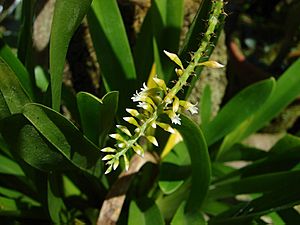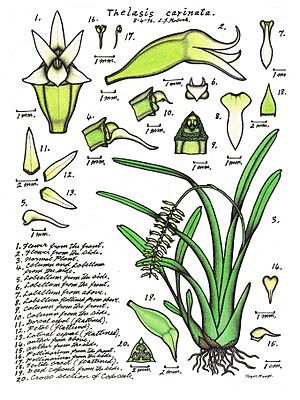Triangular fly orchid facts for kids
Quick facts for kids Triangular fly orchid |
|
|---|---|
 |
|
| Scientific classification | |
| Genus: |
Thelasis
|
| Species: |
carinata
|
| Synonyms | |
|
Synonyms
Phreatia carinata (Blume) Miq.
Eria carinata (Blume) Rchb.f. in B.Seemann nom. illeg. Oxyanthera carinata (Blume) Schltr. Euproboscis griffithii Rchb.f. Thelasis elata Hook.f. Oxyanthera elata (Hook.f.) Hook.f. Oxyanthera papuana Schltr. in K.M.Schumann & C.A.G.Lauterbach Thelasis carinata f. semipelorica J.J.Sm. Thelasis papuana (Schltr.) W.Kittr. |
|
The triangular fly orchid, also known as Thelasis carinata, is a special plant from the orchid family. This orchid grows in clumps and doesn't have pseudobulbs, which are like storage organs for some orchids. It's an epiphyte, meaning it grows on other plants like trees, but it doesn't harm them. It can also be a lithophyte, which means it grows on rocks.
This orchid has groups of two to six stems that stand up straight and are flat. Each stem can have up to six leaves. These leaves have a cool ridge on their bottom side. The plant produces up to fifteen green and white flowers. These flowers grow on a thin but strong stem. You can find the triangular fly orchid in places from Thailand all the way to the southwest Pacific.
Contents
What the Triangular Fly Orchid Looks Like
The triangular fly orchid is a herb that grows on trees or rocks. It has thin roots and flat stems that are about 20–50 mm (0.79–2.0 in) long. These stems grow in groups of two to six.
Each stem has three to six dark green leaves. These leaves are long and narrow, about 200–300 mm (7.9–12 in) long and 25–28 mm (0.98–1.1 in) wide. A cool fact about the leaves is that they have a ridge on their underside. The bottom part of the leaf wraps around the stem.
The orchid produces between six and fifteen flowers. These flowers are green and white and are about 5–7 mm (0.20–0.28 in) long and 3–4 mm (0.12–0.16 in) wide. They grow on a thin but stiff flowering stem that can be 200–400 mm (7.9–16 in) long. This stem grows from where a leaf meets the main stem.
Flower Details
The flowers of the triangular fly orchid are tube-shaped near their base. They are also self-pollinating, which means they can pollinate themselves without needing help from insects or other plants. The part of the flower that holds the seeds, called the ovary, looks like a triangle if you cut it in half.
The flower has parts called sepals and petals. The sepals are about 4–6 mm (0.16–0.24 in) long and 1.5 mm (0.059 in) wide. The side sepals are about 4 mm (0.16 in) long and 1–1.5 mm (0.039–0.059 in) wide. The petals are a bit shorter and narrower than the sepals.
There's also a special part called the labellum, which is like a lip. It's about 4 mm (0.16 in) long and 2.5 mm (0.098 in) wide and curves downwards. You can usually see these orchids flowering between April and June.
Where the Triangular Fly Orchid Lives
The triangular fly orchid likes to grow on rocks and trees. It prefers places that are humid and get plenty of light.
You can find this orchid in many different countries and islands, including:
- Thailand
- Borneo
- Java
- The Lesser Sunda Islands
- Peninsular Malaysia
- Maluku Islands
- The Philippines
- Sulawesi
- Sumatra
- New Guinea
- The Solomon Islands
- Queensland, Australia
- New Caledonia
- Samoa
In Queensland, Australia, it grows in areas between the Iron Range and McIlwraith Range.
How it Got its Name
The scientific name for the triangular fly orchid is Thelasis carinata. It was first officially described in 1825 by a scientist named Carl Ludwig Blume. He published his description in a book called Bijdragen tot de flora van Nederlandsch Indië.
The second part of its name, carinata, comes from a Latin word. It means "keeled," which refers to the ridge found on the underside of its leaves.


